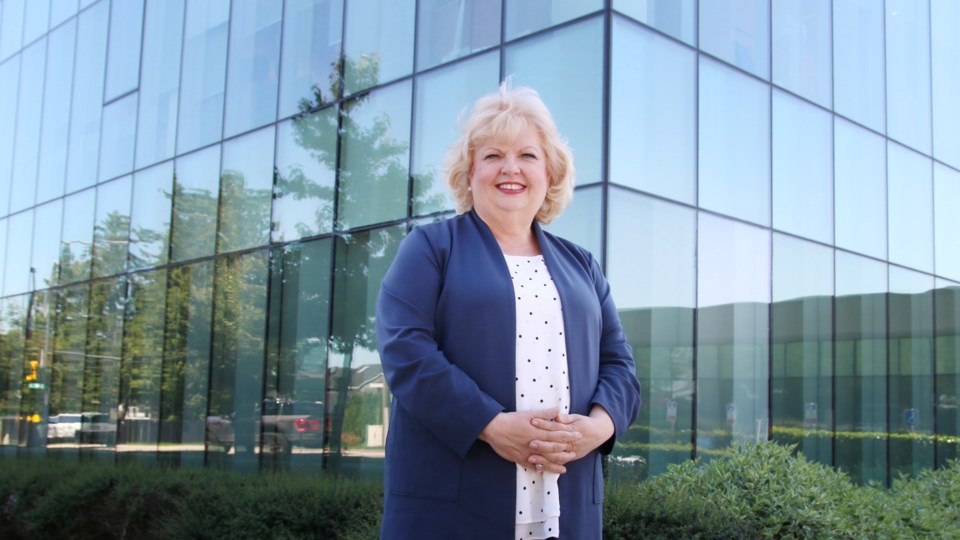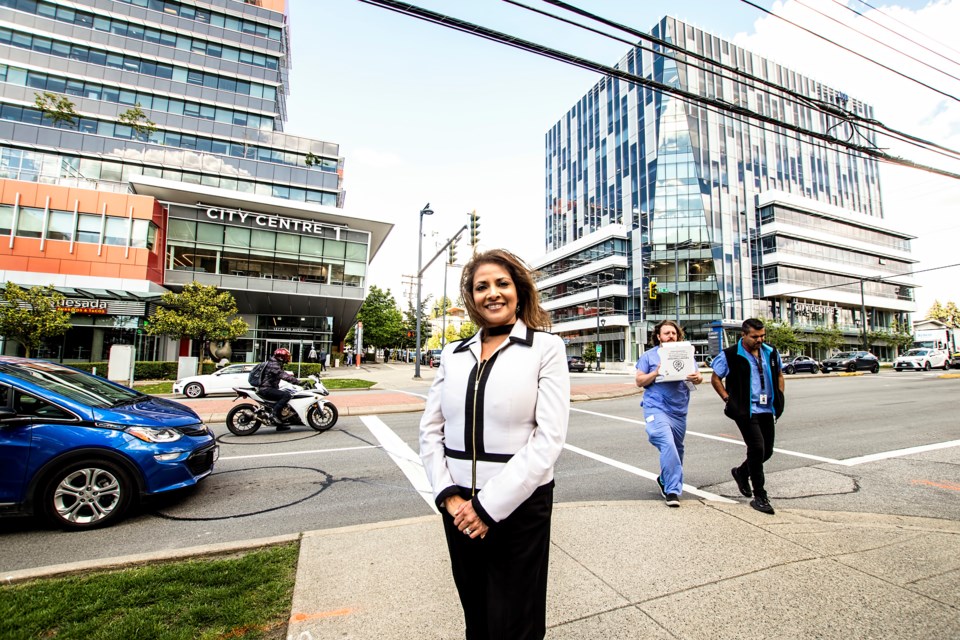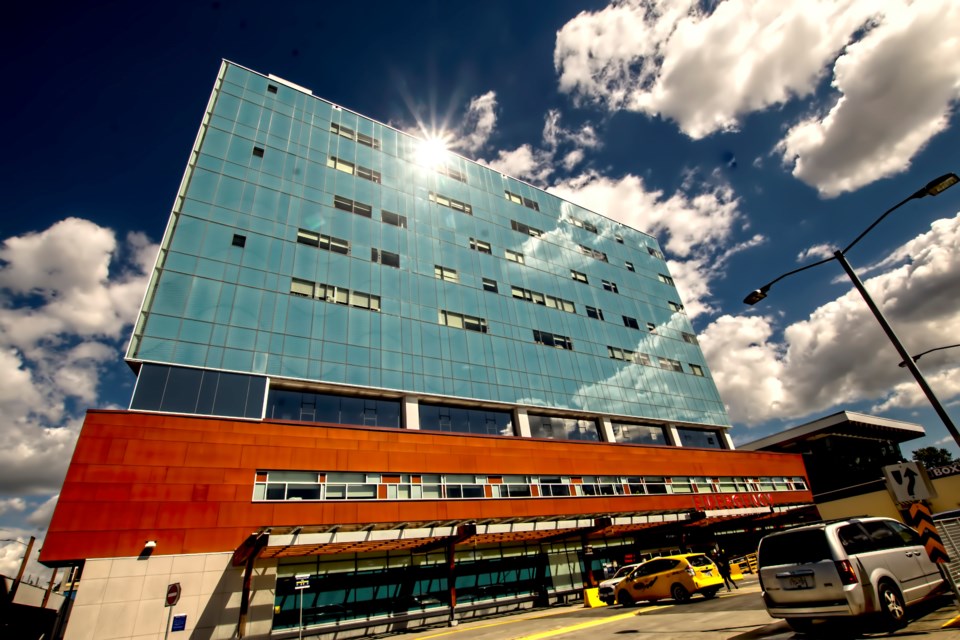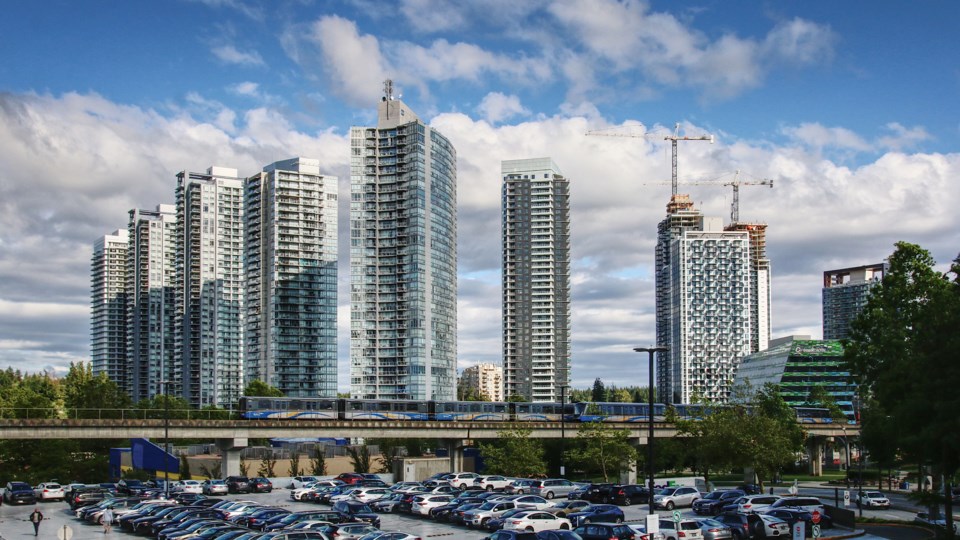Clarity that the Surrey Police Service will oversee policing in B.C.’s second-largest city by November came earlier this month, ending six years of uncertainty that started after residents elected former Surrey mayor Doug McCallum in 2018.
But while current Mayor Brenda Locke now says she accepts the B.C. government’s mandated policing transition from the Royal Canadian Mounted Police (RCMP), the success of the new force is something business advocates in the city say they will watch closely.
“There will be cost implications, no doubt,” said Locke, who has staunchly opposed the transition.
Surrey Board of Trade (SBOT) CEO Anita Huberman told BIV she has spoken with business owners who fear that the new police force will cost more money and employ fewer officers per capita than the RCMP.
“It’s always businesses that bear the greatest burden of taxation,” she said, adding that higher police costs could lead to higher taxes for all.
Fewer officers on streets in the 316-square-kilometre city could also reverse what has been a positive trend: A decline in break-ins, she added.
Statistics Canada data shows overall property crime in Surrey fell to 4,468 incidents in the first three months of 2024, down 12.9 per cent from 5,128 cases in the same three months last year.
There were 127 business break-ins in Q1 of this year—seven fewer than the 134 incidents documented in Q1 of 2023.
Still, the city is not immune from a broader trend of increased shoplifting, perhaps fuelled in part by an increased cost of living.
Theft has hit B.C. retailers’ bottom lines and has evolved to often include what police forces in the province have called “organized fencing operations.”
Reported shoplifting offences in Surrey increased more than 27.3 per cent in the first three months of this year, to 886 incidents from 680 in the same period last year.
Industrial land base key to Surrey’s future
Surrey has been courting manufacturing and distribution businesses by expanding its base of industrial-zoned land, particularly in Campbell Heights.
Decades ago, that part of South Surrey was primarily rural, with significant forested areas and former gravel pits.
Its controversial transition into one of the region’s largest industrial real estate clusters saw business development advocates clash with those who decried what they saw as negative environmental impacts.
What is clear is that the area’s industrial footprint is going to grow, Locke told BIV.
“We’re rebuilding roads,” she said. “16th Avenue is getting redone and we’re doing a lot more accesses into Campbell Heights so the truckers can get there more easily.”
She said the amount of warehousing and distribution space in Campbell Heights will increase because Metro Vancouver needs industrial land and Campbell Heights is ideally situated near the U.S. border and major regional roads.
“It has got lots of straight lines,” Locke said. “One, of course, is to go south and to the border crossing. The other is to go straight north to Highway 1.”

Scarce industrial land means pricier industrial land, and that has the effect of deterring businesses from deciding to locate in B.C.
Industrial landowners in Surrey have seen BC Assessment increase estimated values for their properties, and the city has increased its property tax rate.
S&R Sawmills principal and president Jeff Dahl told BIV that his 60-year-old family business that employs about 300 people on a 120-acre site on the Fraser River has seen soaring tax increases in recent years.
“It would be nice if there was a tax break to try to ignite industry,” he said.
Dahl sent BIV data for his taxes on a 7.66-acre parcel of land, which has a sawmill. His other land includes two more sawmills and a whole-log chipping mill.
The property’s $37,299,400 assessed value in 2024 is 166 per cent more than its $14,005,800 value in 2019. Add higher property tax rates on that increasingly valuable property and Dahl’s 2024 property tax bill was $652,482.82, according to his records.
That is 276.7 per cent more in property taxes than the $173,230.55 he paid in 2019.
At the same time, Dahl’s business has struggled in the past five years amid ongoing challenges faced by the B.C. forestry sector.
He said a tax break would help his business and nearby ventures, such as Teal Jones, which is operating under court-approved creditor protection.
Teal Jones employs about 1,000 employees—including 400 in Surrey, where it operates three sawmills that mostly produce lumber, cedar shakes and shingles.
“It’s scary to think about them not being around,” Dahl said of Teal Jones. “That’s first for the jobs and then, obviously, for sawmilling and the B.C. economy as a whole. We’re just a few kilometers from them and we face lots of the same challenges.”
No one from Teal Jones responded to BIV’s request for an interview.
Dahl said he plans to meet with provincial government officials to suggest ways to make logs more accessible and less expensive, such as lowering stumpage fees.
“They seem to react to markets on the upswing but they don’t react as fast on the downswing,” he said.
Logging and sawmilling employed approximately 90,000 people in B.C. in the early 2000s, according to a Central 1 estimate. That number was around 50,000 last year.
The total allowable cut in B.C. in 2005 was 86 million cubic metres—a figure that was pumped up to salvage mountain-pine-beetle-ravaged trees. Last year’s allowable cut was 62 million cubic metres.
Dahl said that he is committed to his business, and to his staff, and that he has no plan to shut down his mills or to sell his land.
Food manufacturing on ALR land could ease supply crunch
Business owners, industry advocates and local politicians say the provincial government and the Agricultural Land Commission should change regulations to allow food manufacturing and related businesses to operate on Agricultural Land Reserve (ALR) property.
This, they say, will add jobs and economic activity while easing demand for existing industrial land.
Premier David Eby in May told a Fraser Valley economic summit that a “delicate balance” was needed to ensure that “any changes that we make don’t impact that affordability piece for farmers. We do want to continue to have food production on the ALR. We don’t want it to be a situation where farmers are priced out.”
Locke told BIV that she supports more food manufacturing on ALR land.
She said she has spoken with representatives of a dairy who want to build manufacturing facilities on ALR land.
“That would be an awesome thing to have, where people could go and get their cheese directly from the farm,” she said. “Having production on the ALR makes full sense to me.”
BIV spoke with Central City Brewing owner Darryll Frost, who also owns ALNA Packaging Co., which imports, resells and distributes aluminum cans and lids.
Central City Brewing, through ALNA, imports millions of those cans annually to package its beers, Frost said.
If ALNA could build a can manufacturing plant on ALR land, Frost said it would. It could then sell those cans to Central City Brewing as well as other companies.
“Literally billions of cans flow into B.C. by truck, so if you want to ease congestion, build manufacturing here, build those jobs here,” he said.
Attracting companies involved in agriculture technology and food manufacturing has been a key priority for Surrey business advocates for years.
Simon Fraser University’s B.C. Centre for Agritech Innovation is based at its Surrey campus. The Surrey Technology and Skills Centre is also slated to open today (June 25,) Huberman said.
That facility aims to be a hub for research and innovation, and to create global opportunities for the business ecosystem in the Surrey Health & Technology District—a business park in Surrey’s City Centre neighbourhood.
The SBOT and Western Community College have partnered to create the centre, which will initially be in a 2,300-square-foot space that will include a second SBOT office.
“We have a vision,” Huberman said. “We’re starting small because we’re a not-for-profit, but the vision is great and we believe in it.”

New projects add excitement to fast-growing region
Surrey is bursting at the seams with new residents and that is putting pressure on social services such as health care and education.
Efforts are underway to expand services and add other needed infrastructure, such as recreation facilities.
While Statistics Canada’s 2021 census counted 662,248 residents in Vancouver and 560,320 residents in Surrey, it noted that the size gap between the Lower Mainland’s two most populous cities is closing.
Surrey’s population was up 9.74 per cent from 2016, while Vancouver’s population increased by only 4.87 per cent over the same time frame, according to the country’s number cruncher.
Locke told BIV that her staff’s best estimate is that Surrey already has 650,000 residents, including those in basement suites and others who may not have filled out census forms.
She expects that, by 2030, her city will be the most populous in the Lower Mainland.
New home construction is driving growth.
She estimates that about 34,000 new homes are in various stages of development in Surrey, with about 5,200 new homes completed so far this year.
“When you start to look at the growth in terms of the number of actual doors that we’re building in this city, it is amazing,” Locke said.
Surrey’s slight affordability advantage has attracted young families, and that is wreaking havoc on the city’s school system.
Surrey Schools estimates that it has nearly 82,000 students in its district. By comparison, there are approximately 50,000 students in the Vancouver School Board system.
The provincial government has not provided sufficient capital to build new schools or expand existing ones, Locke said.
That means many schools conduct assemblies via Zoom instead of in-person, Locke said, adding that this scenario reduces student interaction and detracts from a healthy education.
“We have more kids in portables in Surrey than some school districts have in total in their districts,” she said. “We have portable washrooms. It is not good.”
Health-care facilities are similarly experiencing overcrowding.

Surrey Memorial Hospital is packed, with the emergency ward sometimes so busy that prospective patients must wait outside. On upper floors, patients often lie in beds in hallways.
Demand there affects care in neighbouring cities, as about 80 per cent of patients at White Rock’s Peace Arch Hospital live in Surrey, Locke said.
The provincial government has promised to build a $2.9 billion hospital in Cloverdale, and site preparation is underway.
“Shovels will be in the ground soon because we have an election in front of us,” Locke said, referring to the Oct. 19 provincial contest.
Surrey’s larger population also requires more recreational facilities and better transportation options.
Locke criticized the province for replacing the former Patullo Bridge with a new $1.4 billion, four-lane bridge instead of a much larger one, but she is excited about the province’s plan to extend Surrey’s SkyTrain line to Langley. Construction on that $4 billion project has yet to begin.
Former mayor McCallum in 2022 floated his grand vision for a 60,000-seat stadium in Surrey.
That concept has since been scaled back and the SBOT has pitched a 12,000-seat stadium, ideally built in time for the 2026 FIFA World Cup so that it can be used as a staging area.
Locke likes the idea but stressed the project is in the “very, very beginning stages.”
Even the location is not clear at this point.
The city could build a stadium on the land it owns in Cloverdale, or on city land in the City Centre neighbourhood, Locke said.
“It creates an energy,” Locke said to explain why the city needs a stadium. “We are a young community. We have a labour force that is ready to go.”



